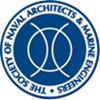利用BDR/ALS技术减小散货船定尺模型阻力的实验参数研究
IF 1
4区 工程技术
Q3 ENGINEERING, CIVIL
引用次数: 7
摘要
航运业务希望开发节能和减阻技术,以解决航运成本和环境问题。据报道,对于慢速行驶的船舶,摩擦阻力占总阻力的80%,迫切需要注意降低摩擦阻力。为了减少摩擦阻力,空气被用作润滑剂,注入运动体下方,称为气泡减阻或空气润滑系统。本文介绍了通过在8000吨载重散货船1:23比例模型下方注入气泡减阻的实验研究结果。在6-10节的速度范围内进行了研究,对于每种速度,研究了.5-3.0 CFM的六种喷射流速的影响。为了研究不同尺寸喷射孔的影响,使用了两种类型的喷射器单元:一种具有直径为1毫米的喷射孔,另一种具有2毫米直径的喷射孔。所进行的研究具有许多实际意义,因为更容易形成更大尺寸的孔,这将减少注入空气所需的功率,从而提高整个技术的效率。1.引言预计未来原油价格将继续上涨,迫使海洋企业依赖研究人员开发节能设备(ESD)和减阻技术。据报道,对于油轮、散货船、超大型油轮(VLCC)和超大型原油船(ULCC)等低速船舶,摩擦阻力占总阻力的80%,迫切需要注意降低摩擦阻力(Lewis n.d.;Larsson和Raven,2010年)。已经研究并应用了许多技术来减少摩擦阻力(Brostow 2008;Abdulbari等人2013;Luo等人2015;Mohammad和Mousavi 2015;Sindagi等人2016)。根据Sindagi等人(2018a,2018b,2018c,2018d)以及Sindagi和Vijayakumar(2020)的进一步研究,得出的结论是,空气润滑比其他技术具有额外的优势,例如它对环境友好,操作非常容易,并且它导致低操作成本和高节能。此外,通过空气润滑,Merkle等人(1983)和Madavan等人(19841985)将平板的阻力降低了80%。本文章由计算机程序翻译,如有差异,请以英文原文为准。
Experimental Parametric Investigation to Reduce Drag of a Scaled Model of Bulk Carrier Using BDR/ALS Technique
The shipping business expects to develop energy-saving and drag-reducing techniques addressing the cost of shipping and environmental problems. It has been reported that for slow-moving vessels, frictional resistance accounts for up to 80% of the total resistance, needing urgent attention to reduce the same. To reduce frictional resistance, the air has been used as lubricant, which is injected below the moving body known as Bubble Drag Reduction or the Air Lubrication System. In this article, results obtained from experimental investigations into drag reduction of a 1:23 scaled model of an 8000-ton deadweight bulk carrier by injecting air bubbles below it are presented. Investigations were carried out for a speed range of 6-10 knots, and for each speed, the effect of six injection flow rates of .5-3.0 CFM were investigated. To investigate the effect of different sizes of injection holes, two types of injector units have been used: one with injection holes of 1 mm diameter and the other with injection holes of 2 mm diameter. The study carried out has many practical implications because it is easier to create bigger size holes which will reduce the power required to inject air, thereby increasing the efficiency of the entire technique.
1. Introduction
It is projected that crude oil prices will continue to increase in the future, forcing marine businesses to rely on researchers to develop energy-saving devices (ESD) and drag-reducing technologies. It has been reported that for slow-moving vessels such tankers, bulk carriers, very large crude carrier (VLCC), and ultra large crude carrier (ULCC), frictional resistance accounts for up to 80% of the total resistance, needing urgent attention to reduce the same (Lewis n.d.; Larsson & Raven 2010). Numerous technologies have been studied and applied in reducing the frictional drag (Brostow 2008; Abdulbari et al. 2013; Luo et al. 2015; Mohammad & Mousavi 2015; Sindagi et al. 2016). Based on further studies Sindagi et al. (2018a, 2018b, 2018c, 2018d) and Sindagi and Vijayakumar (2020), it is concluded that air lubrication has additional advantages over other technologies, such as it is environmentally friendly, the operation is quite easy, and it results in low operating costs and high energy savings. Moreover, with air lubrication, an 80% reduction in the drag of the flat plate was achieved by Merkle et al. (1983) and Madavan et al. (1984, 1985).
求助全文
通过发布文献求助,成功后即可免费获取论文全文。
去求助
来源期刊

Journal of Ship Research
工程技术-工程:海洋
CiteScore
2.80
自引率
0.00%
发文量
12
审稿时长
6 months
期刊介绍:
Original and Timely technical papers addressing problems of shipyard techniques and production of merchant and naval ships appear in this quarterly publication. Since its inception, the Journal of Ship Production and Design (formerly the Journal of Ship Production) has been a forum for peer-reviewed, professionally edited papers from academic and industry sources. As such, it has influenced the worldwide development of ship production engineering as a fully qualified professional discipline. The expanded scope seeks papers in additional areas, specifically ship design, including design for production, plus other marine technology topics, such as ship operations, shipping economic, and safety. Each issue contains a well-rounded selection of technical papers relevant to marine professionals.
 求助内容:
求助内容: 应助结果提醒方式:
应助结果提醒方式:


